How H-Wave Helps Your Body Relieve Pain and Recover From Injury
What really happens within your body when it goes through the recovery process? Whether it’s from a sustained injury or after surgery – how does your body work to get your system and the affected area back to homeostasis? Read below to learn more about your body’s natural recovery process and how
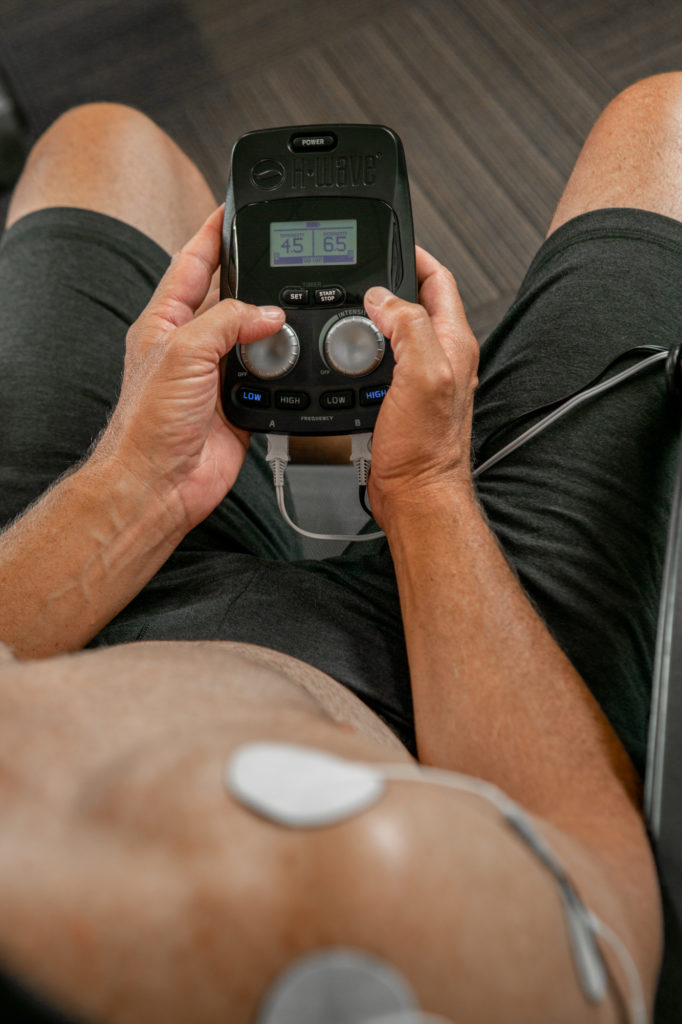
The Basics of Recovery
How to get an injured area back to homeostasis
Whether you’ve had surgery, or suffered a significant injury, or are dealing with some type of chronic pain or chronic inflammatory condition; the goal in all these cases is to bring the tissues and the area back towards homeostasis in order to feel better. You don’t just want to mask symptoms and you don’t just want to feel good momentarily, but you really want to help that area recover. The goal is to help improve the health of those tissues in that area. That is also the key to providing rehabilitative and lasting benefits. In order to bring tissues and an environment back towards homeostasis, the absolute foundation of that is clear:
You must flush out waste and bring in nourishment.
Whatever you may call it (congestion, waste, swelling, edema), it’s what causes so many problems and is at the root of so many symptoms that patients often have. So what you need to do is flush all that waste out. Simultaneously, you’ll need to bring more fresh blood and nourishment into that area. Nourishment includes all the supplies that the body uses to repair those tissues to be healthy, to feel good, and to perform the way they’re supposed to. So, how do we flush the waste out?
Flushing Waste Out – How the Lymphatic System Works
While the heart beats, it sends blood throughout the body. Oxygenated blood flows through arteries from the heart into all areas, and deoxygenated blood is pumped back to the heart through veins and so on. During your body’s natural recovery process, large waste particles are produced and can create congestion since they can’t go through the venous system. This is what occurs so often for people who have had an injury or surgery or suffer from chronic conditions. In order to remove these large waste particles, it requires the lymphatic system.
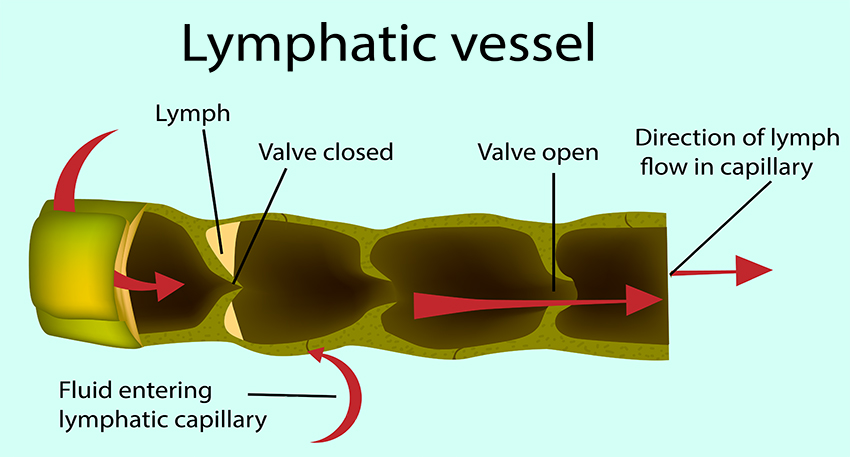
The lymphatic system is a network of thousands and thousands of vessels throughout your body going out to all your extremities. It’s those lymphatic vessels that absorb larger waste particles and excess fluid from all the extremities and filter out the bacteria in order to eventually return the healthy excess lymph fluid back into your bloodstream. But the lymphatic system doesn’t have a heart beating to force the movement of fluid and waste through it. It’s a passive system. In order to absorb those fluids and move that waste away from your extremities and back into circulation, it requires the lymphatic system to be activated by compressing the lymphatic vessels.
The lymphatic vessels have all these one-way valves. As the vessel is compressed, it moves the waste up a little bit through the one way valve up to the next chamber, and then it’ll stay there. When the vessel continues to be compressed, it’ll move that waste up to the next chamber, and the next chamber, and the next chamber, and it can’t go backwards because of those one-way valves. This compression of lymphatic vessels can be done in lots of ways. The way it works on a normal everyday basis is through locomotion. Your own natural body movement in life compresses those lymphatic vessels and makes sure that waste is not accumulating in the extremities or in any parts of your body and that it’s constantly moving.
The Challenge – Engaging Lymphatics When You’re Injured
When you’re injured or you’ve had surgery or you’re suffering from a chronic condition, a few things can happen which prevent waste from moving through the lymphatic system and allow congestion a chance to build up and cause discomfort. One example is – you’re unable to move that much, either because you’re in so much pain, or that part of your body is immobilized and you physically can’t move, or it’s too painful to move. Another example is – that your body has already done so much work trying to repair tissues that even if you are moving, it can’t keep up because there is already too much accumulation of congestion and waste, so you need to move more. That’s why you might hear so often that exercise is the best medicine and movement is so good. But what if movement is going to exacerbate the situation and make the environment worse?
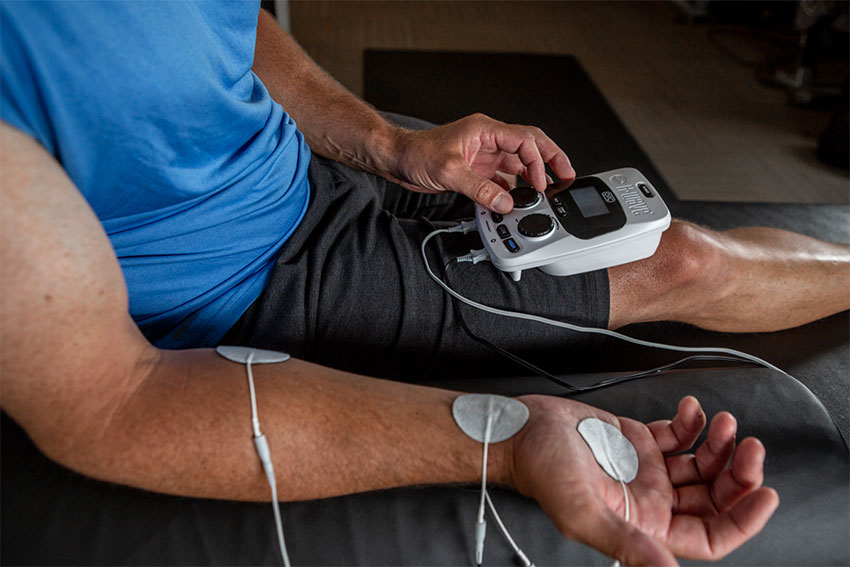
Sometimes you can move a little bit, and that’s why physical or occupational therapy can be beneficial to get your body moving and help move some of the waste through the lymphatic vessels. But if you move too much, i.e.: too much walking, too much stretching, too much work with a therapist, too much time on a stationary bike or whatever it may be; then you start actually working those muscles and that can very often exacerbate an injury or aggravate a post-op area. When you work an area too much, you start causing fatigue of those muscles. This type of muscle fatigue is micro trauma and it damages those tissues, so you’ll have an inflammatory response and again, exacerbate the issue. So, you DO need to compress and activate those lymphatics, but you need to be careful to do it in a way that doesn’t make any issues worse. This is where H-Wave can help, and it’s what makes
The Solution – How H-Wave’s Low Frequency Activates the Lymphatic System
H-Wave has a low frequency setting that works uniquely by activating muscles through non-fatiguing muscle contractions. By contracting muscles with H-Wave, you are creating very significant compression of the lymphatic vessels. What’s so special about the
Compared to other electrical stimulation
There are other electrical stimulation devices on the market, but they really have different purposes. Their primary purpose is often that of a traditional muscle stimulator, which is to contract muscles for muscle re-education. In that case, you get strong, harsh muscle contractions which are good for muscle reeducation, but put significant stress and tension on the tissues and fatigue the muscles. So they can have some benefit in very small doses. But they can’t have really significant benefit for any significant period of time, since using them for more than very small doses would aggravate the issue and cause a rebound swelling or inflammatory response. The ability of
Compared to other techniques
Other techniques like compression and massage are actually good techniques for activating lymphatics. However, external compression and massage are so much more limited than contracting the muscle like H-Wave does. If you want to compress the superficial lymphatic vessels (the ones close to the skin), you could probably do that easily with a massage or a compression device. But the reality is, it’s almost impossible to get the many lymphatic vessels that are much, much deeper in the tissues using these methods. You would need to compress or massage so hard that you’d really be over-compressing the superficial vessels. The benefit of
Bringing Nourishment In – How the Circulatory System Works
Now the next step towards recovery and getting tissues back to homeostasis is bringing nourishment into the affected area. The tissues are not thriving because they need nourishment and oxygenated blood, and they want to be repaired. But all the congestion and waste can make it hard for that fresh oxygenated blood to get into the area. So while you’re system is flushing the waste out, you also want to simultaneously be bringing nourishment in.
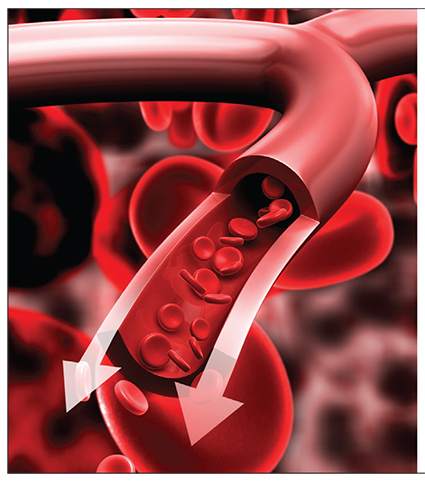
The way nourishment is naturally going to come in is by movement. If you want more circulation, you need to move more. The more you move muscles, the more you activate muscles. This causes blood vessels to dilate, which causes blood flow to increase. Vascularity improves the more you condition an area, the more you move it. But just like with lymphatics, when you’re injured or you’ve had surgery or you suffer from a chronic condition, often you physically can’t move. The area is immobilized or it’s too painful to move. Or maybe you can move in small doses which is beneficial, but you’d have to be very careful to not move too much. It’s easy to think “a little bit of movement helps, so let me move a lot more and it’ll help more.” But when you start moving a lot more, you’re now putting stress on those injured or damaged tissues and you’re going to potentially exacerbate the issue. Or you’re going to move so much that you fatigue those muscles, which can happen very quickly on someone who has been immobilized or injured. This again, would cause an inflammatory response just like mentioned previously with the lymphatic system. So you want to increase the amount of nourishment coming in, but without causing any of those negative side effects: exacerbating injuries or surgery repair sites, or causing an inflammatory response.
How H-Wave’s Low Frequency Helps the Circulatory System
Clinical research has shown that muscle activation affects nitric oxide, the neurotransmitter involved with many things in the body including vasodilation (dilating blood vessels). Since H-Wave’s low frequency creates muscle activation, when you’re using the
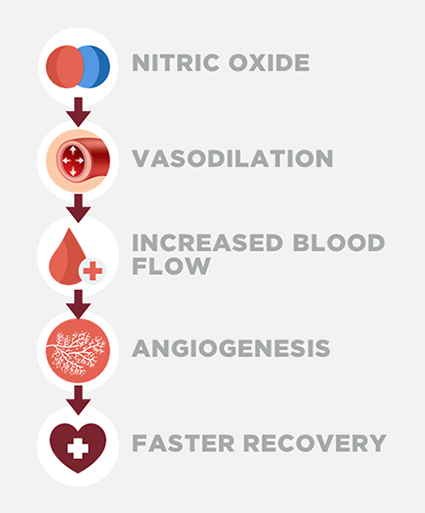
Unlike other methods or devices, and unlike regular movement, you can use the H-Wave’s low frequency to create muscle activation for multiple hours every day without worsening anything, and without causing an inflammatory response. This can really enhance and significantly grow the benefits you’re seeing from any active recovery techniques like walking or therapy that you’re already doing. What research has also shown is that when you use
But by using H-Wave regularly, the clinical research shows that you can improve vascularity through angiogenesis: the formation of new blood vessels. When this occurs, you can hopefully get back to your baseline vascularity and possibly gain even more. When you improve vascularity in a region, it means that your body can deliver more fresh oxygenated blood to that region 24/7, whether
The foundation of recovery is the ability to flush out waste and bring in nourishment, and nothing does that more effectively than H-Wave without any negative side effects.
If you have a condition or injury that has caused an issue where you can’t move enough to flush out the waste with daily movement, therapy or exercise, then
Effective Pain Control with H-Wave’s High Frequency
The reality is that there are types of conditions sometimes simultaneously occurring to this problem of tissue recovery and the desire to bring tissues towards homeostasis. Sometimes there are other, more directly nerve-related issues going on. With chronic low back pain for example, there may be a herniated disc or something that’s actually impinging upon the nerve. That nerve is constantly firing. That nerve has gone into a chronic pain cycle. It’s overactive and firing regularly which is causing intense pain. Moving nourishment and waste and bringing that area towards homeostasis may be beneficial and may be very desirable, but something more is needed first to shut down the pain in those cases. That’s where H-Wave comes in with its secondary setting.
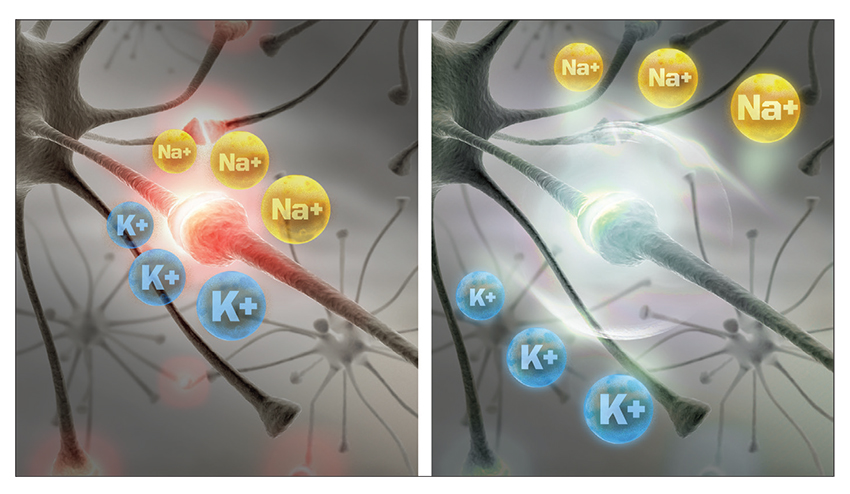
Though moving nourishment and waste is the foundation of what
In simple terms, we’re trying to shut down that pain. We’re not going to be able to cure the underlying physiological issue going on or stop the impingement of the nerve. But what we can do in about a 30-minute session is shut down that pain to a point where you’re not feeling any pain, or your feeling very little pain, and keep it away for hours after treatment. A single 30-minute treatment in the comfort of your own home can create hours of pain relief. However, every patient is different. It might start with an hour of relief or it might start with six to eight hours of relief, but what most patients see are cumulative benefits. The more they use the product, the longer and longer the results will last and the more significant the results can be.
H-Wave’s Ability to Relieve Pain Compared to TENS
H-Wave’s high frequency signal is so effective at shutting down pain, that the technology is actually cleared by the FDA to be used as electronic anesthesia in dentistry. While this might not be exactly the type of pain you’re dealing with, it’s a great example of the capabilities of H-Wave. The ability to calm down an overactive nerve and shut down that pain signal is so significant, that
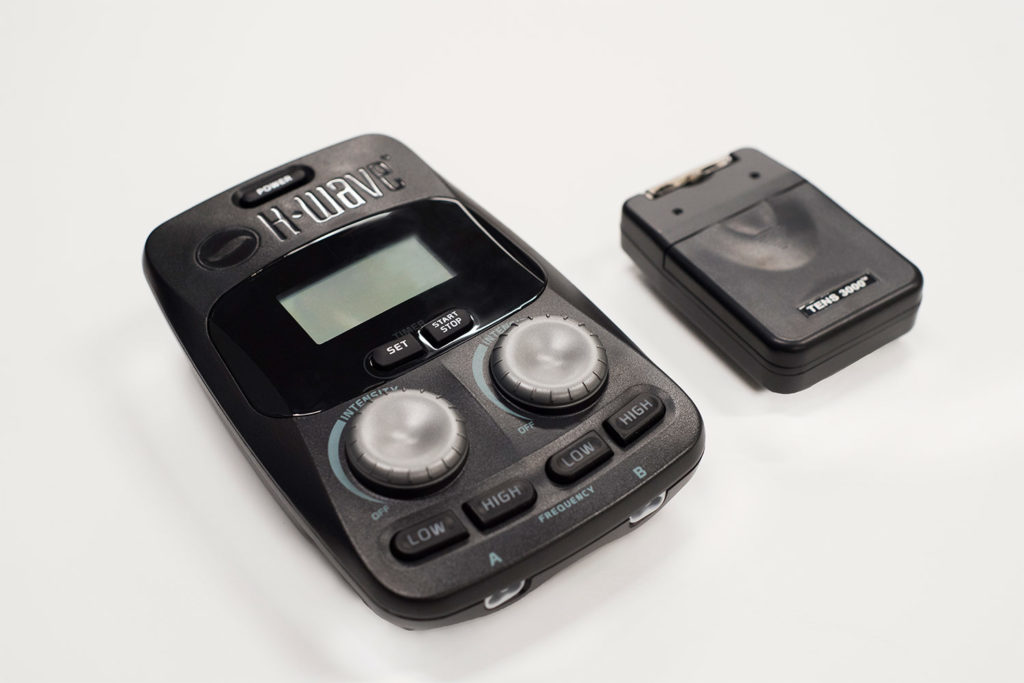
This is something much, much more substantial than for example, a TENS device and its ability to shut down pain. As you may be familiar, a TENS at best will mask the pain while the device is on. But there’s a lot of pain that TENS just isn’t able to address. Even while the TENS device is on, it can’t conquer severe chronic pain. At best, it may minimize pain while turned on but there’s no lasting benefit after the device is turned off. Additionally, there’s no rehabilitative benefit. It’s not doing anything to improve tissue health, bring those tissues or that area towards homeostasis or towards any type of recovery.
Benefits of Using Both H-Wave Frequency Settings (High and Low)
Often, many of our patients use both of our modes of operation in order to get maximum lasting benefit, depending on what their issues are. They might want instant pain relief by shutting down that nerve (high frequency). Or the pain relief might come from flushing out waste and bringing in nourishment using low frequency. But for some people they need both. They need to immediately shut down that overactive nerve and break the chronic pain cycle, and they simultaneously (or soon after) need the other part of our treatment. Our low frequency treatment that is flushing out waste helps the body work towards long-term improvement of the affected area and bringing that area towards homeostasis. When you put these two modes of operation together, you have a treatment that is so powerful and so effective at helping so many patients regain the lifestyle they want. It can reduce medication usage and help patients get back to the activities of daily living that they truly enjoy . . . and in the end, live a better life.
You may also like:
Modalities for Effective Chronic Pain Relief to Use At-Home
Movement Without Motion – How to Get Your Body Moving Again When You’re in Pain